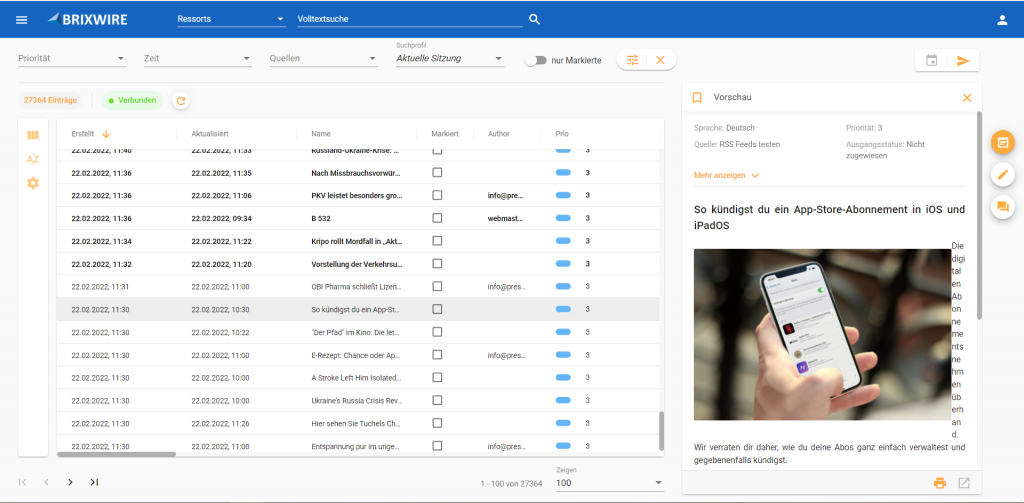Release notes from V1 to V2
Update to version 2.1.18.13, July 2022
We have been working for the last months to bring you a significant improvement of BrixWire News Hub compared to the installed version, i.e. a real major release.
We are changing from the classic version (V1) to the core version (V2). Here we would like to tell you more in detail!

What is new?
Here’s a look at what’s new on the platform

- Platform independence
- Rest API
- Angular UI
- Loadbalancer
- JWT Support
- Push notification of client
- Auto publishing, AnyFirst approach
- Docker
- News Translation
- New Plugins
Platform independence
BrixWire runs on Linux or Windows systems. It runs with MS SQL Server or PostgreSQL server as DB Backend.
Rest API
A REST API (Level 2 with ODATA) is implemented in parallel to the existing APIs. It still needs refinement and completion, but it is integration-ready.
Angular UI
Finally reached after a long journey. Besides the classic UI, the new Angular UI is available. It is faster, less resource hungry, more customizable or brandable, and simply better.
- Fresh Design!
- General overhaul with more simplicity
- All the features plus the new ones improved through better design
- New Themes
- Dark Mode available for each theme

- Performance improvements
- Angular and smart change detection enables an incredible fast table
- Faster search
- Session profile
- Search criteria get saved automatically to a session profile
- No search gets lost ever
- Table
- New design
- Excel-like features for column adjustment
- Keyboard navigation with smart shortcuts
- Useful design for special columns like priority
- Optimize the table to your needs with many new customization options
- Stories automatic update
- Incoming stories will be shown automatically without a refresh or a new search
- Never miss a story with configurable highlighting for incoming stories
- You will be always sure to be connected through automatic reconnects and a live-updating connection info
Loadbalancer
Improved support for several instances of BrixWire running in parallel under a Loadbalancer.
- Separation of inputs
- Improved inter-server communication
JWT Support
All Apis are secured by JSON Web Tokens now, to enable the UI to work in public reachable environments.
Push notification of client
The classic version relied on polling to update the UI for new stories. The core version has an implemented push mechanism, which leads to lower resource consumption (e.g. tablet usage) and reduced latency.
Auto publishing, AnyFirst approach
We enhanced the auto publishing features of BrixWire. By consequence, you can publish articles from your CMS directly and without human interaction to WoodWing or vice versa. A pair of Input and Output plugins are required for this to work. More in detail about AnyFirst in this post.
Docker
In the first step, it is a hosting alternative for our customers. In a further step, the deployment of Docker is used for automated updates of released versions.
Advantages include a more stable environment, as Docker is customized and released by us, as well as less dependency on the environment and its installation, and often more favorable hosting conditions.
News Translation
We’ve integrated AI translation into our News Hub. So you too can translate news into a variety of languages in seconds. Learn more about news translation in this post.
Plugins
Here a look at the new plugins

- Overhauled RSS-Feeds
- Overhauled file system plugin
- Woodwing Plugins
- WordPress Plugins
- LivingDocs Plugins
- Mail Plugins
- Twitter Input Plugin
- Facebook Plugins
- REST Plugins for generic input and output
- Telegram Input Plugin
- Brix2Brix Plugin
Overhauled RSS feeds
RSS feeds with several versions of RSS are supported now. RSS Specification is somehow unclear or too old. By consequence, countless formats are out there, and the formats contain mixed structure (i.e. elements from various versions of the standard).
We did improve the existing RSS plugin a lot, including cleanup of malformed Html, etc. Besides that, the load is reduced by allowing RSS feeds to use 5 threads in parallel for pulling information. This should reduce the load.
Overhauled file system plugin
The file system plugin now supports building up chains, i.e. it can act as a relays station to share imported content with many instances. Besides that, a file system output plugin is available, which allows publishing for consuming application using a filesystem-based technology.
Woodwing Plugins
The WW plugins are overhauled, and they now support fully duplex mode, i.e. you can mirror a WoodWing instance with BrixWire for input and output.
WordPress Plugins
WordPress instances can now be used as a source (to read articles from) or as a target to publish articles to.
LivingDocs Plugins
Similar to WordPress the CMS “LivingDocs” is added to the ecosystem. It allows full-duplex support, as is possible with the WordPress plugin.
Mail Plugins
Mail plugin allows watching configurable mail hosts and transfers incoming mails to publishable stories. Vice versa it allows for publishing to various mail recipients.

Twitter Input Plugin
Tweets are read from Twitter acc. to configured filters and can be imported.
Facebook Plugins
Posts and images can be imported and published to various and configurable goals. It is possible to support various output formats. Stories and images in BrixWire can be exported and published on Facebook as a post.
REST Plugins for generic input and output
BrixWire provides generic input and output, using generic interfaces and configurable transformations. Important for customers, who want to extend the system with their own news sources.
Telegram Input Plugin
The Telegram plugin is developed within the framework of the Ukraine Server, and it goes beyond a mere import plugin, offering interactive elements to users. There are two broad directions:
- Import Plugin
As usual with other plugins, posts from public channels can be imported. This is Read Only functionality to access public news in the sense of an RSS reader.
- Reader Reporter Plugin
Private groups can be formed to share information such as video, audio, images, and text with the BrixWire platform. The functionality can be used to get information on the spot on the one hand and on the other hand, it can be used to verify stories. We are currently working on a viable concept to form such private groups.
Brix2Brix Plugin
Connects two BrixWire servers, i.e. it is possible to access data areas of another BrixWire server. This plugin is suitable, for example, for local newsrooms that are to be connected to a newsroom.
Two characteristics are supported:
- Import Modus
The data is available at the receiving server, they are copies of the intended stories, which are stored incl. connected assets in the target server.
- On Demand Modus
Stories are only imported when a Publish or other client-side operations are performed that require the story to be deeply embedded in the local instance.
Why should you update?
- Faster and more intuitive UI.
- You can include social media channels in your workflow with the new social media plugins.
- A lot of new possibilities for Your publishing needs are opened.
- We are heading for a regular update process as well, to keep You up to date regarding security and functionality.
Let us know, what You think!
If You have uncovered requirements, ideas or questions, please leave a comment to us or contact us.
